Khortytsia Cemetery Gravestone Project
Werner Toews
Imagine seeing the headstone, for the first time, of your great-great-grandmother who died over a century ago. Imagine seeing her name etched in an elegant black marble stone with gold inlay letters. The strange part, however, is that you didn’t visit a cemetery to see the stone. It was in a place that you never would have imagined it to be. This was my experience on July 23, 2019.1
A day earlier I learned through a Facebook post by Roman Akbash, that Max Shtatsky and a colleague Mykola Anatoliyovych Svydran from the Khortytsia National Reserve (KNR), had started an excavation at 61-A Zachinyaeva St. in Upper Khortytsia (Verkhnya Khortytsia). The building and property were once part of the village of Khortytsia. This was one of the first villages that was established by Mennonite settlers in 1789.2 This area is now a suburb of the city of Zaporizhzhia, Ukraine.
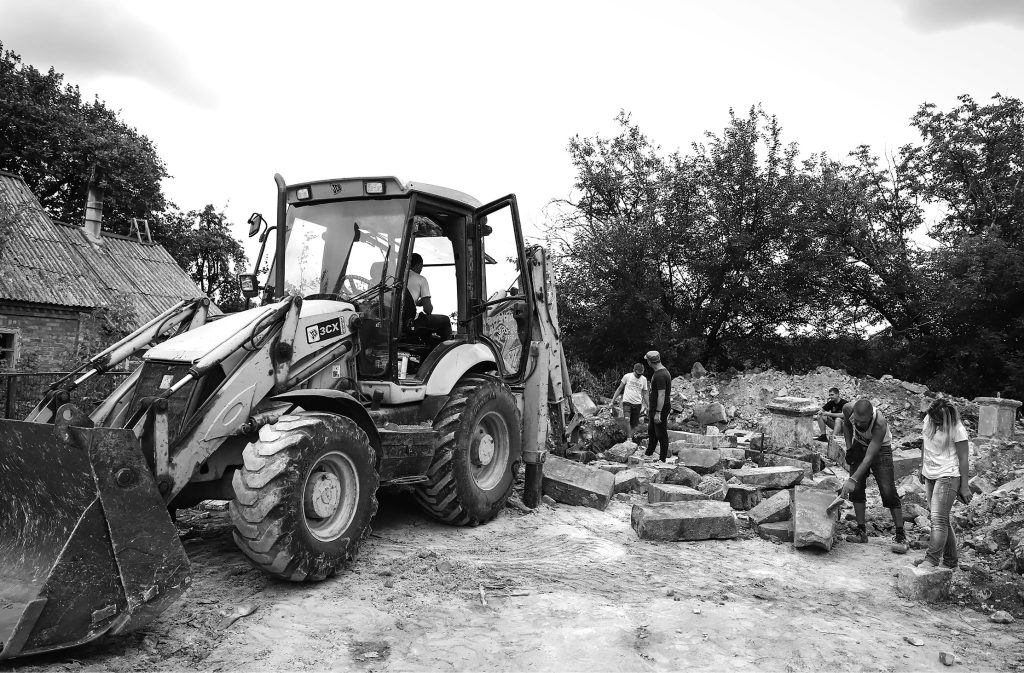
The excavation was a few years in the planning and, after receiving permission from the director of the KNR, Maxym Ostapenko, the project manager, Max Shtatsky, started the dig. This was no ordinary archeological dig, as I soon learned. The goal was to dig out the foundation of this old abandoned brick building or barn that had sat empty for many years. The roof had collapsed and only one of the four brick walls was still standing. The building was very close to the street and, in fact, the excavation started on the foundation of the wall that ran parallel to the street. The purpose of the dig was to uncover and remove the foundation stones that were rumoured to be gravestones of the Khortytsia Mennonite church cemetery. The cemetery had been demolished long ago by the Soviet government in the 1930s. This was the same cemetery where my great-great-grandmother, Katherina Koop, had been laid to rest in 1910.
Local historians believe that the building is located on the former property of a D. Pätkau. A search of an interactive map from the website of Willi Vogt, from circa 1915–1925, revealed that a David Pätkau owned a property in the village of Khortytsia on a street called Alte Reihe or Old Row.3
Information provided on the site indicated that the Pätkau family was evicted from the property in 1930 after being labelled kulaks by the local government authorities.4 The term kulak was used by the Soviets to describe wealthy or prosperous peasants. In 1929 the Soviet government, in an effort to collectivise agriculture, implemented a campaign of “dekulakization” or a plan to eliminate the kulaks as a class. Many peasants had resisted the plan to join the collective farms and dekulakization was one means to convince them to reconsider. By 1934 many of the kulaks had been “deported to remote regions of the Soviet Union or arrested and their land and property confiscated.”5
It would appear that the David Pätkau family had been victims of the dekulakization campaign. No further information on the fate of this family has been found at this time. Vogt’s website does, however, indicate that a building was constructed on the Pätkau property in 1936. The information also revealed that some of the building materials used were gravestones from the Khortytsia cemetery.
Attached to the property information is a video produced in 2016 that features Roman Akbash describing his connection to the building and the possibility that the foundation was made from gravestones from the Khortytsia cemetery.6 The cemetery was located approximately seven hundred meters to the northeast of the former Pätkau property.
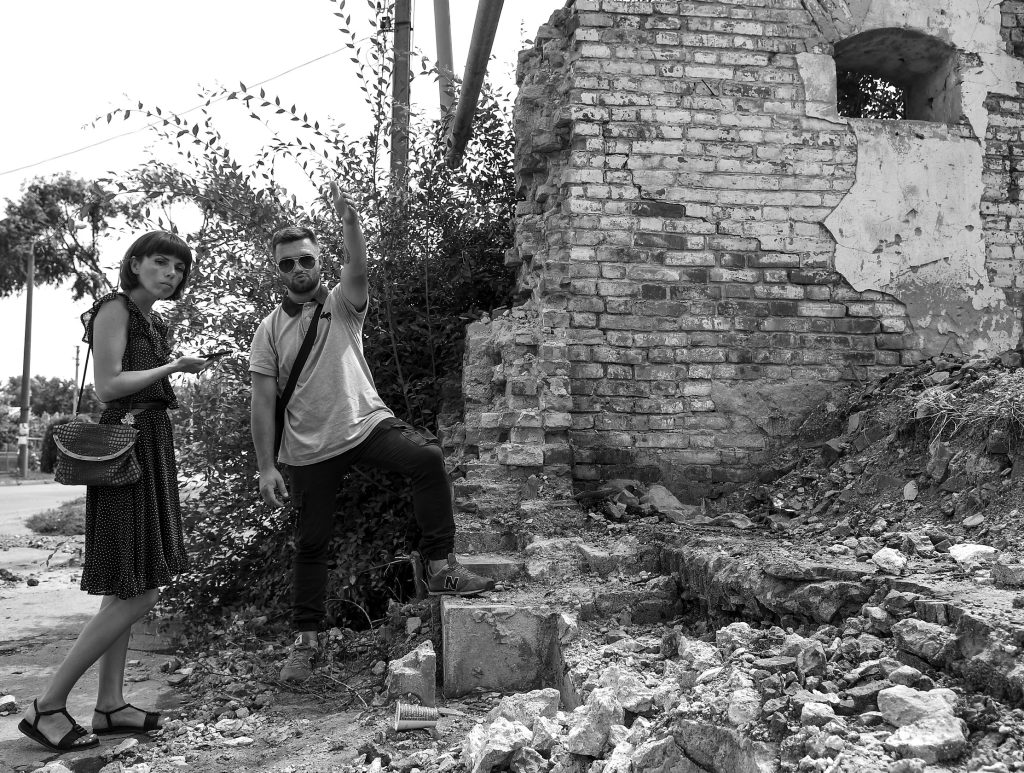
The Destruction of Cemeteries
During the years of research conducted on the fate of my ancestors in the former Soviet Union, I discovered some of the reasons why the Soviet government destroyed cemeteries and used the gravestones for building materials. Under the Soviet government’s anti-religious policy, many churches and cemeteries were destroyed. The gold, silver, and religious icons owned by Orthodox churches were looted and the cemeteries next to these churches were desecrated. In the 1930s the Soviets estimated that there were over 40,000 tons of usable metal in old cemeteries that could be appropriated for their national industrial drive. Common gravestones were taken for building projects and marble headstones were used to make statues that appeared as decorations in larger cities such as Moscow.7 The policy of using cemeteries for parks, sports fields, and building projects was implemented throughout the USSR.
Mennonite churches and cemeteries were subjected to similar abuses. With church ministers being harassed and people discouraged from attending church services, the Khortytsia Mennonite Church was eventually closed by the authorities. The official reasons were that the local “Building Commission” deemed the building unsafe and the congregation could not afford the money for the costly repairs. This, however, didn’t stop the authorities from converting the church into a movie theatre in 1935.
A first-hand account of what occurred in Khortytsia in the 1930s can be found in the memoir of my great-aunt, Anna Sudermann. The date of the destruction of the Khortytsia cemetery in Anna’s memoir and the year that is described by the people in Zaporizhzhia, differ by approximately four years. Information from local citizens and from Vogt’s website indicate that the destruction of the cemetery likely occurred sometime between 1935 and 1936.
A quote from Sudermann’s memoir on the destruction of the Khortytsia and Rosental (a neighbouring village) cemeteries:8 “In 1939 and 1940, the cemetery (Khortytsia) was levelled and turned into an athletic field. Later on, this fate also befell the Rosental cemetery. The land was needed for a barn. The barn housed calves for the collective farm. We found this out (in December 1966) from a report of a tourist who had been travelling in Russia, and who had visited Khortytsia and Rosental.
The report from Russia in Der Bote (German-language newspaper published in Canada) said that during the levelling of the Rosental cemetery, the bones from the graves were ploughed up to the surface. A few of the German people who still lived in or had returned to Khortytsia, gathered the bones and buried them in a common grave deeper in the valley. The memorial gravestone of Johann Bartsch, our deputy of 1789, was then placed on top of this mass grave of bones from the last Khortytsia Mennonites. This gravestone had miraculously survived all the fronts of the last world war that passed over it.9
With deeply felt gratitude I would like today to shake the hands of these brave men for this deed of love, as my mother, sister-in-law Lena, and my brother Heinrich’s little daughter, as well as many close relatives were laid to rest there in the Rosental cemetery.”
A further connection to the use of gravestones as building materials was documented by Delbert Plett in his visit to Ukraine in 1998. During his Kleine Gemeinde tour, the group visited the cemetery in Ebenfeld to commemorate the Mennonites that were massacred in December 1919 and buried in the Ebenfeld cemetery in a mass grave.10 While at the cemetery, they were informed by a local resident that the Mennonite gravestones had been taken away during the Soviet period and had been used to build a nearby kolkhoz (collective) barn. Here is an account of what the group saw that day, as described by Delbert: “The building had recently been bulldozed down and we could see gravestones and parts of gravestones littered about where the bulldozer had spread them out. Hopefully they will remain there so that the next tour can attempt to do some inventory of these stones. We had to go on, the day was short and there were many more villages to visit.”
The following year Delbert traveled back to Ukraine for the Chortitza ’99 conference and made a side trip to the Borosenko colony where the villages of Ebenfeld and Steinbach are located. Delbert was able to inspect the barn and made the following discovery: “This time we were able to stop. A quick investigation of the remnant walls showed that our fears had been correct. One of the gravestones incorporated into the wall was perfectly preserved (maroon granite stone), ‘Hier Ruht Maria Teichroeb, born 1850 Juli 12, gest. Mai 15, 1911.’ In honour of her memory I took a photo of her gravestone with Harold Jantz standing beside it.”11
Project Members
The history of the brick building in Upper Khortytsia was also known by the local citizens. After the details of the project were released to the public on July 22, Roman Akbash shared his connection to the building. Roman is a local historian who works as the creative director for the museum of the History of Weapons in Zaporizhzhia. He conducts walking tours in the city and is familiar with the history of Mennonites in Khortytsia. During his childhood, he and his family lived in a house beside the building.
Later in life Roman became interested in the history of the Mennonites in Khortytsia and learned that the foundation of the building was made from gravestones from the destroyed Khortytsia cemetery. He also related that the cemetery became a sports field where, as a youth, he played soccer on the former cemetery grounds. Years later, a school (#86) was built on the property and is still used today.
The driving force behind the gravestone project is Max Shtatsky. I came to know Max a few years ago as we had corresponded by email on a number of occasions. We shared an interest in the Mennonites of Khortytsia and the fate of the Mennonites during the Great Terror. As a child, Max lived in a house in the former village of Khortytsia.
During his childhood, Max became interested in learning about the “Germans” who lived in Khortytsia, as well as Soviet-era architecture. After completing high school, Max attended the Zaporizhzhian National University where he earned a degree in history. After receiving his degree, Max was hired by the Khortytsia National Reserve in 2010. After attaining the position of research scientist, Max began conducting full time research on the Mennonites of Khortytsia. His goal was to learn about their lifestyle, language, religion, and cultural practices, which differed from the other residents of Zaporizhzhia. His strong interest in learning about Mennonites and their lost history was his motivation to excavate the building foundation and uncover Mennonite gravestones. Max believes that by researching and finding Mennonite-related artifacts, he can rehabilitate their past and provide some justice to the descendants of the Khortytsia Mennonites.
It was on the initiative of Max Shtatsky and the director of the Khortytsia National Reserve, Maxym Otapemko, that this project was made possible. Maxym Ostapenko has been the director of the KNR for the past twelve years and has collaborated in the past on various projects with North American Mennonite historians. When speaking to him about the project, Ostapenko revealed a family connection to the former Mennonites of Khortytsia. He related that one of his wife’s grandmothers was a Rempel. To move the project forward, Ostapenko and his wife, Galina, made a personal donation that facilitated the rental of equipment for the first few days of the excavation.
The Project’s Progress
On July 22, the first day of the excavation, Shtatsky’s goal was to remove dirt and rocks from the foundation and possibly uncover a few gravestones. The property had fallen into disrepair and the lot was being used by locals as a dump site for construction materials. After removing debris from the first wall foundation, the back-breaking work of excavating the stones began on a very hot and humid day. One of the first stones uncovered was a pedestal for a gravestone with no inscription. The second stone belonged to a female with the maiden name of Siemens, 1820–1887. It became quite clear from the start of the excavation that the stones had been cut or broken to create somewhat of a uniform foundation for the walls. The top of the Siemens’ stone was missing and a search for the missing piece and other missing pieces would continue throughout the excavation.
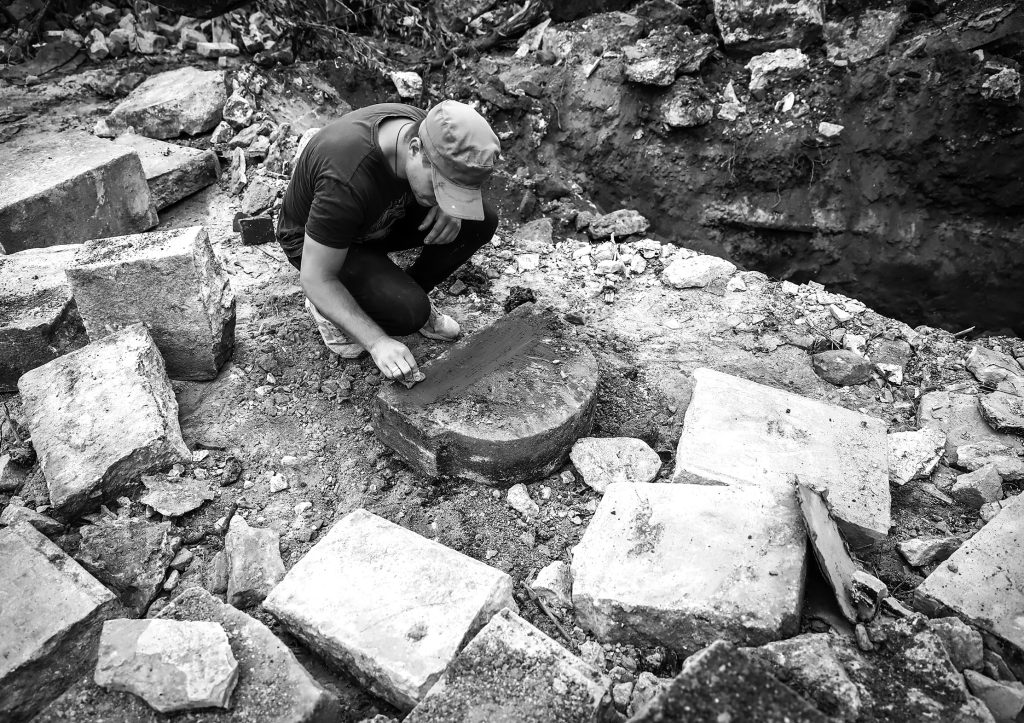
On the second day, the stone of my great-great-grandmother, Katherina (nee Pätkau) Koop (1839–1910), was found. It was an elegant black marble stone with gold inlay lettering. The stone was in relatively good shape with some damage and, of course, covered in grout that was used by the builders to hold the stones together. It is not known whether the Pätkau that owned the lot is a close relative of Katherina but she did have a half-brother by the name of David Pätkau, who died in 1919 in Khortytsia.
The husband of Katharina was Abraham Jacob Koop (1838–1920), a blacksmith by trade who worked for P. H. Lepp. It was Lepp who helped Koop get started in producing agricultural equipment. In 1864 Koop established his own factory in Khortytsia which was so successful that he established further factories in Einlage and Aleksandrovsk.12
As the day progressed, more gravestones were identified and removed by hand. It soon became quite apparent that to complete the excavation of the four foundation walls, heavy equipment would have to be involved in this extensive excavation. It also became clear that the foundation walls contained many gravestones. The excavation by hand continued for the next few days and some of the newly discovered gravestones were transported to the Khortytsia National Reserve property. As news of the discovery spread through the city and on social media, a press conference was scheduled for July 26 at the office of the KNR.
At the press conference, Max Shtatsky reported that eighteen headstones had been removed from the foundation wall. Shtatsky also advised that a preliminary study of the site revealed that there could be forty to two hundred gravestones in the foundation of the building. Some of the recovered stones had been taken to the museum site and displayed to the media. Information on the next stage of the excavation was also provided to the media with a plan on the scope of the work and the funds needed to complete the project.
The first priority was to excavate all the stones and transport them to the property of the Khortytsia National Reserve. The Khortytsia National Reserve did not have the resources to fund this unique project and, as a result, a request for donations was posted on Facebook. The initial request for donations was made to citizens of Zaporizhzhia. A letter was also sent to the Zaporizhzhia city council asking for assistance with the project.
The project was now gaining interest and had many followers on the Facebook group, “Mennonite History and Genealogy.” As the news spread through the city of Zaporizhzhia, so did the interest in the project. The almost daily updates and reports generated many questions and interest from North American Mennonites and Mennonite organizations.
The request for donations was also expanded to include Mennonites in North America. Due to some challenges with transferring funds from foreign countries to Ukraine, a system to facilitate donations was set up through a board member with the Friends of the Mennonite Center in Ukraine. The board also made a generous donation which greatly assisted in moving the project forward.13
As funds became available, the excavation continued into the months of August and September. Heavy equipment was used to clear the site of debris as well as the arduous task of digging up the foundation walls. The foundation was measured to be nine meters by twenty meters, with four layers of foundation stones. Max Shtatsky continued as the project manager with the help of some hard-working volunteers.
It should be noted that many of the stones were broken or cut during the construction of the foundation. During the excavation, all pieces of the gravestones that were found were collected and brought back to the KNR property for cleaning and restoration. One hopes that it may be possible to reconstruct some of the gravestones. There were also a number of gravestone pedestals located that will be matched up to gravestones.
There is practically no one still alive from that period that could provide information on the destruction of the cemetery and the construction of the building other than some information from a local historian who has since passed away. During the press conference, Khortytsia National Reserve director Maxym Ostapenko related that local historian, Volodymyr Shovkun, had conducted walking tours of Upper Khortytsia in the 1970s and early 1980s where he pointed out buildings that were thought to be constructed with Mennonite gravestones. Shovkun advised that the buildings were constructed at night by prisoners in an effort to conceal the materials that were being used for the construction of the building. He stated that at the same time, the Soviets were destroying the Mennonite cemetery that contained hundreds of gravestones.14One can assume that they were using the gravestones for those buildings. At the conference Roman Akbash stated that five Mennonite settlements in the territory of modern Zaporizhzhia had their own cemeteries. He related that all were destroyed except one that is located on Khortytsia Island.
While researching the history of the Mennonites in Khortytsia, no information, photographs or lists of the deceased in the cemetery could be found. Therefore, this project is an important historical find for the descendants of the people that were buried in the destroyed Khortytsia cemetery. For me, this project was an opportunity to see my family history come to life in a way that I never would have imagined. Finding these stones is an important part of our collective history in Ukraine.
On September 7, Max Shtatsky reported that the excavation of the foundation was complete. The excavation, however, will continue on a smaller scale in the coming weeks as it was rumored that there was a basement in the building. I anticipate that there will be further discussions in the future on the final resting place of the stones with participation by North American Mennonite organizations. This story is far from over and will be updated in further publications.
Lists of Gravestones
On September 13, Max provided a list of over eighty-six stones that were located. There are additional pieces of gravestones that will have to be cleaned and reassembled to identify the deceased. The final list of recovered stones is a work in progress and will take a few months to complete.
The Genealogical Registry and Database of Mennonite Ancestry (GRANDMA) numbers have been included beside the names. The names with no numbers beside them have not been located on the GRANDMA database to date.
The question marks beside some of the numbers indicate there is less than a hundred per cent match to the name and dates recorded on GRANDMA.15 Further research will have to be conducted to locate the names and proper dates on various databases or family histories.
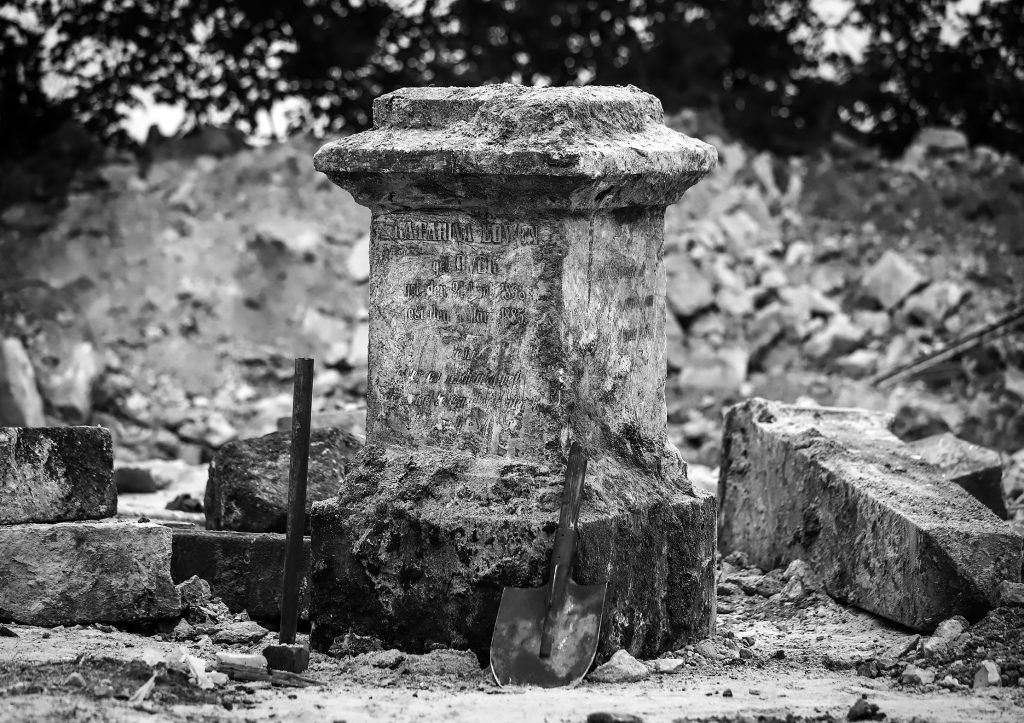
1. Bergen B. 1812–1861 #529181?
2. Braun Peter 6.01.1794–28.10.1851 #267133
3. Braun Peter 1858 #753559? or #314171?
4. Dyck Agata (born Braun) 22.05.1823–9.11.1896
5. Dyck Elizabeth (born Epp) 8.08.1849–31.12.1886 #509238
6. Dyck Jacob 16.03.1804–8.11.1847 #175866
7. Dyck Helena (born Siemens) 21.08.1814–13.11.1889 #505902?
8. Dyck Maria (born Regier) 4.03.1830–3.12.1905 #506902
9. Dyck Maria (born Reimer) 17.02.1846–14.01.1900 #179970
10. Dyck Jacob 16.11.1831–19.05.1893 #506645
11. Epp Johann 4.12.1830–17.03.1888 #69115?
12. Epp Elisabeth (born Leike) 1.07.1819–2.05.1904 #198741?
13. Epp Gertruda (born Hamm) 10.11.1858–29.09.1880 #127021
14. Epp Gertruda (born Goosen) 1783–1848 #64083
15. Epp Helena (born Thiessen) 14.08.1797–14.04.1864 #77581
16. Epp Helena 7.4.1878–10.07.1879 #435594
17. Epp Johannes 18.09.1880–11.04.1881 #435595 same stone as 16.
18. Epp Marie (born Thiessen) 11.01.1879–13.05.1906 #127006
19. Epp Elizabeth (born Perk) 5.04.1830–25.01.1904 #127004
20. Fast Peter 29.08.1883–24.02.1890 #429335
21. Hamm Katharina (born Wilms) 18.08.1817–2.02.1887 #467073
22. Hamm Maria (born Braun) 28.08.1865–2.08.1889 #467073
23. Hamm Peter 18.08
24. Hamm Justina 1847–1907 #343347?
25. Hildebrandt Agatha (born Hubert) 14.07.1827–12.07.1889 #160905?
26. Hildebrandt Gerhard 15.10.1819–4.02.1889 #53087?
27. Hildebrandt Katherina 15.10.1867–6.05.1877 #265841
28. Hildebrandt Helena 2.04.1857–08.06.1877 #265837 same stone as 27
29. Janzen Maria (born Holzrichter) 21.09.1858–09.11.1910 #509263
30. Klaassen Helena (born Hamm) 27.12.1837–20.01.1909 #343274
31. Koop Katharina 27.11.1839–12.02.1910 #146874
32. Koop Peter 18.12.1844–17.07.1889 #148253 two stones
33. Krager Maria (born Löwen) 22.03.1868–17.08.1903
34. Krahn Gerhard 10.10.8105–10.11.1855 #396292?
35. Krahn Katherina 14.07.1806–11.05.1855 #765841?
36. Löwen Abraham 28.08.1836–05.06.1908 #353458
37. Löwen Gerhard 20.05.1821–16.10.1887 #89231
38. Löwen Helena 25.12.1862
39. Löwen Katharina 21.10.1838–4.03.1885 #353480; Abraham #353458?
40. Martens Heinrich 19.12.1819–27.02.1888 #451504
41. Niebuhr Abraham 31.12.1836–22.02.1893 #151861
42. Niebuhr Anna 19.02.1875–11. 03.1881 #175118
43. Niebuhr Eva (born Hamm) 6.06.1853–3.02.1896 #461749
44. Niebuhr Gerhard 2.05.1882–15.01.1901 #508152
45. Niebuhr Heinrich 24.01.?–10.03.?
46. Niebuhr Heinrich 10.06.1880–18.12.1883 #508153
47. Niebuhr Katharina 6.02.1874–13.05.1884 #508157
48. Niebuhr Maria (born Löwen) 30.08.–10.10 #151872
49. Pätkau Jakob 28.06.1816–12.10.1908 #126987
50. Pauls Abraham 6.03.1812–9.04.1886 #196189
51. Pauls Anna 25.07.1886–31.07.1886 #459006
52. Pauls Dietrich 4.02.1844–14.10.1907 #452057
53. Pauls Gerh. Gerhard
54. Pauls Kornelius 23.10.1813–29.11.1853
55. Pauls Margareta (born Dyck) 5.12.1833–8.08.1907 #452207
56. Pauls Peter 14.08.1834–06.09.1906 #452198 same stone as 57
57. Pauls Maria (born Penner) 05.05.1811–05.01.1856 #196194
58. Pauls Helena (born Dyck) 7.02.1845–21.11.1864 #452048
59. Penner Helena (born Klassen) 22.08.1835 #494691?
60. Penner Jacob 5.05.1831–?.07.1911 #494692?
61. Penner Johann 28.01.1828–25.07.1914 #199527
62. Peters Franz 19.11.1834 #308843
63. Regier Abraham 1821–1888 #508242?
64. Sawatzky Jacob 21.1.1831–21.1.1908 #267380?
65. Sawatzky, His wife Anganetha Sawatzky (born Giesbrecht) 3.05.1833–5.10.1902 #267381?
66. Schellenberg Bernhard 2.02.1840–13.02.1888 #127042
67. Schellenberg David 30.10.1868–18.12.1874 #127048
68. Schulz Margaretha 1831–1887 #214709?
69. Schulz Margaretha also Koop (born Wiens) 22.01.1851–5.02.1909 #119564
70. Schwarz Heinrich 1790 #196217?
71. Siemens (born ?).16.01.1820–17.01.1887
72. Siemens Katharina (born Klassen) 20.01.1768–18.02.1843 #108860
73. Siemens Peter 16.04.1765–1.12.1847 #136330
74. Thiessen Helena 26.03.1883–14.04.1883 #353010
75. Thiessen Margaretha 26.09.1892–29.09.1892 #353005 same stone as 74
76. Thiessen Agatha 16.08.1895–5.09.1895 #353004
77. Toews Heinrich 10.09.1869–10.01.1888 #199453
78. Unrau Abraham Wilhelm 30.04.1813–28.10.1890 #199042
79. Von Kampen Katherina (born Siemens) 10.07.1884–10.04.1890 #452064
80. Von Kampen Maria (born Hildebrandt) 13.08.1864–9.11.1898 #452327
81. Von Kampen Johann 21.12.1834–14.07.1855 #452632
82. Von Kampen Jacob 05.07.1793–26.07.1867 #196808
83. Wilms Peter 1813–1863 #197298
84. Seldner Karl Adolf 1818–02.03.1894
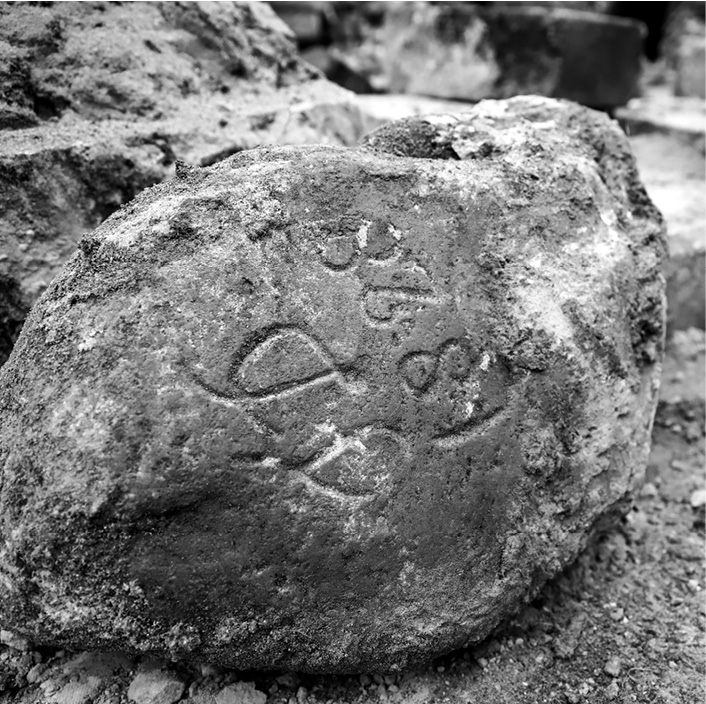
- I would like to acknowledge the following people for their involvement with this project: Max Shtatsky for his assistance with this article and his determination to find the gravestones of our ancestors; Maxym Ostapenko and his wife Galina; Roman Akbash; Mykola Anatoliyovych Svydran and Maksim Klimov; Olga Rubel; Friends of the Mennonite Center in Ukraine and board members Geroge Dyck, Alvin Suderman; Julia Slyva, director of the Chortitza gravestone charitable fund and the Khortytsia National reserve. Thank you to all the people who made a donation to this project. ↩︎
- Cornelius Bergmann and Cornelius Krahn, “Chortitza Mennonite Settlement (Zaporizhia Oblast, Ukraine),” in Global Anabaptist Mennonite Encyclopedia Online (hereafter GAMEO) (1955), https://gameo.org/index.php?title=Chortitza_Mennonite_Settlement_(Zaporizhia_Oblast,_Ukraine), accessed August 13, 2019. ↩︎
- “Karten und Dorfpläne von mennonitischen Orten in Russland,” Mennonitische Geschichte und Ahnenforschung, https://chort.square7.ch/Karten.htm, accessed August 13, 2019. ↩︎
- Willi Vogt, “Mennonitische Ahnenforschung in Chortitza Hof C52 und C51 wohnten…”, https://chort.square7.ch/Rosental/C52.html, accessed August 13, 2019. ↩︎
- “Kulak,” Encyclopaedia Brittanica, https://www.britannica.com/topic/kulak, accessed August 13, 2019. ↩︎
- https://www.youtube.com/watch?v=PTGGbrqDd58, accessed September 12, 2019. ↩︎
- Catherine Merridale, Night of Stone: Death and Memory in Russia (London: Granta, 2000), pp. 174–75. ↩︎
- Sudermann, Anna. “Lebenserinnerungen von Anna Sudermann (1893–1970).” Unpublished memoir, 1970. ↩︎
- Bartsch was one of two delegates from Prussia who negotiated the land settlement with Empress Catherine II for Mennonites to settle in southern Russia. See Christian Neff and Richard D. Thiessen, “Bartsch, Johann (1757–1821),” GAMEO (2010), http://gameo.org/index.php?title=Bartsch,_Johann_(1757-1821), accessed August 13 2019. ↩︎
- Delbert Plett, ”Kleine Gemeinde Heritage Tour, May 3-23, 1998,” Preservings 12 (June 1998): 43, https://www.plettfoundation.org/files/preservings/Preservings12.pdf. ↩︎
- Delbert Plett, “The Old Homeland, Borosenko and Molotschna,” Preservings (Dec. 1999): 76-77, https://www.plettfoundation.org/files/preservings/Preservings15.pdf. ↩︎
- Cornelius Krahn, “Koop, Abraham Jacob (1838–1920),” GAMEO (1957), https://gameo.org/index.php?title=Koop,_Abraham_Jacob(1838-1920), accessed Sept. 12, 2019. ↩︎
- “Our History,” Friends of the Mennonite Centre in Ukraine, https://www.mennonitecentre.ca/our-history/, accessed August 30, 2019. ↩︎
- Eugene Nazarova, “Zamurovani nadrobki zasnovnikiv zaporiz’kikh pidpriamstv” (July 29,2019 ), https://www.radiosvoboda.org/a/30081179.html. ↩︎
- “Project Overview,” GRANDMA, https://www.grandmaonline.org/gmolstore/pc/Overview-d1.htm. ↩︎
